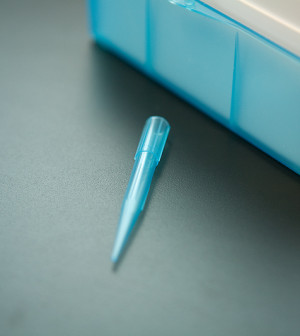- Skip Storing This Everyday Product in the Fridge Door
- Green Tea + B3 Pairing May Boost Brain Health
- Navigating Your Midlife Crisis: Embracing New Possibilities
- City Raccoons Showing Signs of Domestication
- Mapping the Exposome: Science Broadens Focus to Environmental Disease Triggers
- One Week Less on Social Media Linked to Better Mental Health
- Your Brain Changes in Stages as You Age, Study Finds
- Some Suicide Victims Show No Typical Warning Signs, Study Finds
- ByHeart Formula Faces Lawsuits After Babies Sickened With Botulism
- Switch to Vegan Diet Could Cut Your Greenhouse Gas Emissions in Half
Scientists Grow Functional Vocal Cord Tissue in the Lab

Scientists have succeeded in growing functional vocal cord tissue in the lab — a step toward a new treatment for people with substantial vocal cord damage.
In the United States alone, about 20 million people have vocal impairments — including some who have significant scarring or tissue loss in the vocal cords’ delicate lining. That lining (called the mucosa) vibrates when air passes over it, which generates the human voice.
Serious damage to the vocal cord lining is often related to trauma, or surgery or radiation to treat cancer. And right now, the treatment options are limited.
With no good way to repair the damage, the alternative — in theory — is to implant new vocal cord tissue, said Nathan Welham, the senior researcher on the new study and an associate professor at the University of Wisconsin School of Medicine, in Madison.
That is easier said than done, but in the Nov. 18 issue of Science Translational Medicine, Welham’s team reports a first step in making such a therapy a reality.
Using purified cells from the human larynx (voice box), the researchers were able to engineer new vocal cord mucosa that was capable of making sound — in the lab, at least.
Much more work lies ahead, according to Welham.
“Voice is generated by a complex and beautiful biological system,” he said.
So that means the “ideal” replacement tissue for the vocal cords has to meet high standards: It has to be flexible enough to vibrate, Welham explained, yet sturdy enough to withstand significant stress — since the vocal cords can vibrate at a rate of up to 1,000 times per second.
“No other tissue in the human body is subjected to those types of biomechanical demands,” Welham said.
For the study, the researchers began with cells taken from the vocal cords of one cadaver and four patients who had their larynxes surgically removed for non-cancerous conditions.
The researchers purified and grew the cells, then applied them to a collagen “scaffold” that gave them a structure to develop around. Two weeks later, the cells had fused to form layers that resembled a natural vocal cord lining; the cells in the tissue were even producing many of the same proteins that normal vocal cord cells do, the study authors said.
Next, the researchers transplanted the tissue into larynxes taken from cadaver dogs, then passed warm, humidified air over the tissue.
The air, it turned out, produced a vibration and sound — something akin to a kazoo, according to Welham.
But while the success is exciting, he said, no one knows how this will work out in humans.
Two doctors who treat voice disorders agreed.
Dr. Michael Johns, director of the University of Southern California Voice Center, said the findings are “one of the most important steps forward in the treatment of vocal cord scarring.”
But he stressed that key questions remain: Would transplanted vocal cord tissue even survive in the human larynx? If it does, will it ultimately be rejected by the immune system? Or fail to function well?
Dr. Ramon Franco, medical director of the voice and speech lab at Massachusetts Eye and Ear, in Boston, said these early findings offer “hope” to people with severe vocal impairments, but also pointed to the unknowns.
One obstacle, Franco said, is making sure transplanted vocal tissue can “auto-regulate” itself — maintaining its size, structure and integrity. Cell overgrowth would be a potential worry, he explained, since the transplanted tissue would be in the airways.
It’s also unclear how the logistics would work, according to Franco. For instance, would doctors take patients’ own cells, from the remaining healthy tissue in their vocal cords, to make replacement tissue?
According to Welham, a patient’s own cells might not be needed. He said it’s possible that vocal cord cells from donors could be “banked.” Then when a patient needs them, some cells could be thawed and matured into vocal cord tissue.
As for the issue of immune system rejection, the researchers saw some encouraging signs. They tested the vocal cord tissue in mice engineered to have human immune responses, and found no evidence of rejection.
So it’s possible, Welham said, that transplanted vocal cord tissue will turn out to be like transplanted corneas — which do not set off an immune reaction in recipients.
But that remains to be seen. And both Johns and Franco stressed that patients should not expect to see this as a therapeutic option any time soon.
“In my opinion, the timeline would probably be about five to 10 years from now,” Johns said.
And while voice disorders are common, he said, it’s likely that only a minority of patients, with substantial vocal cord scarring, would be candidates.
More information
The American Academy of Otolaryngology — Head and Neck Surgery has more on voice disorders.
Source: HealthDay
Copyright © 2025 HealthDay. All rights reserved.










